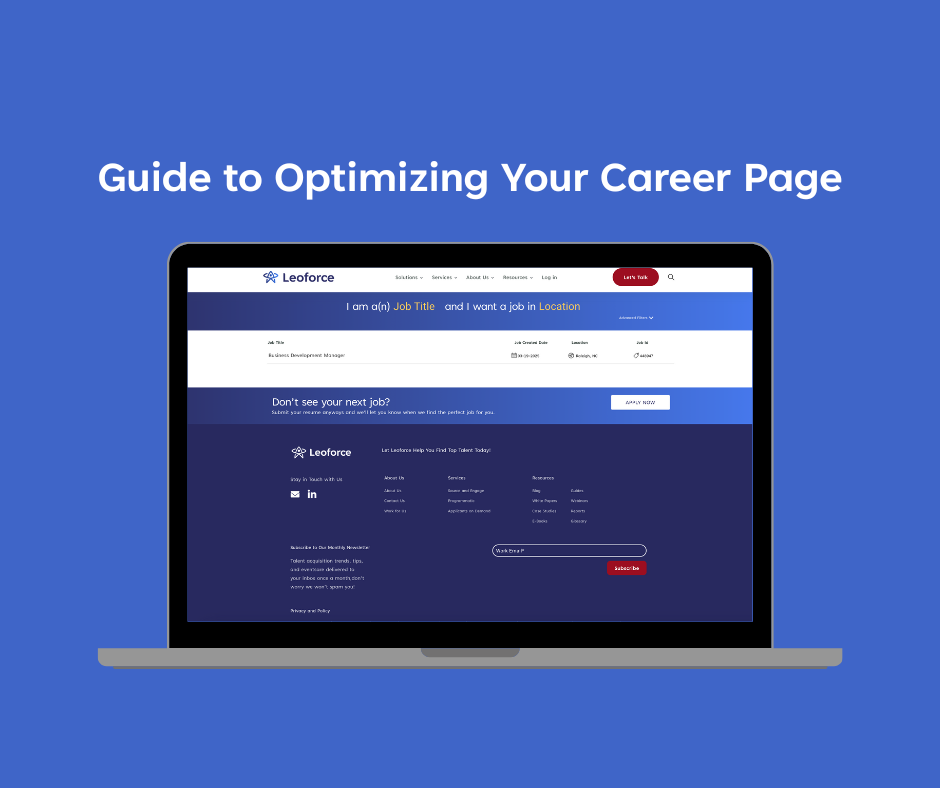Passive recruiting: What is it and how to leverage It?

Finding qualified candidates to join your team is no doubt a challenge. In fact, 76% of hiring managers admit that attracting the right candidates is their greatest challenge. After all, you’re looking for more than just the right skills and experience – you’re searching for the right fit for your organization.
Simply posting a job description and waiting for the right candidate to apply doesn’t always work. You’re limited to whoever chooses to apply, regardless of whether they’re truly qualified for the role. Passive recruiting opens the door to a much bigger pool of talent, making it easier to identify candidates with specific skills or experience.
Struggling to source candidates to join your team? We’ll explain why you should invest in passive recruiting and how to get started.
What is passive recruiting?
Passive recruiting is the practice of attracting potential candidates to your business who aren’t actively looking for a job. This can include networking with other industry professionals or referrals from employees.
By adding passive recruiting to your talent acquisition strategy, you’re able to broaden your talent pool and attract qualified candidates who may not be actively looking for work but are open to new opportunities.
The benefits of passive recruitment for your organization
There are several benefits of investing in a passive recruitment strategy, including:
- Creating a larger pool of talent to recruit from
- Lower competition. Passive candidates are less likely to be interviewing with other businesses
- Competitive advantage by sourcing top talent, regardless of their current work status
- Improving your employer brand by fostering relationships with passive job seekers
- Identifying potential candidates with a specific skill set for hard-to-fill positions
Passive recruiting strategies
Here are five ways to apply passive recruiting to your recruitment strategy.
Start a customer referral program
Good people know good people, and your employees are no different. Encourage staff to recommend family or friends that may be a good fit for the organization. Offer an incentive like a one-time bonus or an extra paid vacation day.
Engage with your existing talent pool
Use an applicant tracking system (ATS) to organize candidates for previous roles. Although some of these candidates may not have been a match for the position they were applying for, they could have the skills and experience to fill a new vacancy.
Reach out to these applicants to see if they’re still looking for work or open to a new opportunity. Tell them about the new role.
Since so many people spend time on social media, it’s become an increasingly popular tool for recruitment. Using LinkedIn Recruiter, you can search passive candidates based on their job titles or skills. You can contact both active and passive candidates through InMail.
You can also use other channels like Facebook, Twitter, and Instagram to highlight your company’s culture and values. Consider engaging with prospective candidates.
Network with other industry professionals
Take advantage of industry networking events like conferences, trade shows, or meetings to connect with passive candidates. You can use a website like Eventbrite or CitySocializer to discover events happening near you. Introduce yourself, the company you represent, and any job openings to potential candidates who may be a good fit.
Use online job boards
Sites like Indeed and Workopolis allow you to search active and passive candidates based on their industry, skills, experience, and education. Once you’ve identified a potential fit, reach out to see if they’re still searching or open to a new opportunity.
Tips for recruiting passive candidates
Here are a few tips to help you successfully recruit passive candidates.
Build your employer’s brand
How potential applicants view your business matters. 75% of Americans would refuse a job with a company that has a bad reputation. Building your employer brand is one way you can improve your reputation among staff and potential job candidates.
Initiate a conversation
Start by introducing your company and the opportunity to the potential candidate and ask them to schedule a brief call to share more. If they say no, move on. They have your contact should they change their mind. Use the phone call to highlight the requirements of the role and what they need to know about the organization.
Improve your candidate experience
Create a frictionless recruitment process to keep passive candidates interested and engaged. Send the job description and benefits package to prospective applicants right after your initial phone call so the opportunity stays top of mind. Respond to questions or inquiries right away and make it easy for the candidate to apply for the role.
Highlight growth potential, perks, and benefits
A passive candidate isn’t looking for work because they already have a job. So, what perks, benefits, or opportunities can you offer that their current employer can’t? Typical motivators include:
- Better compensation
- More or better benefits
- Remote or hybrid work
- Flexible work schedule
- Work/life balance
- Opportunities for development
Frequently asked questions
What is meant by passive talent?
Passive talent or passive candidates are those currently employed and not actively looking for a new job. These candidates may be open to new opportunities depending on compensation, benefits, or other perks.
Are passive candidates better?
Passive candidates are typically better because they’re carefully selected based on their skills and experience with respect to your position’s role and responsibilities. Passive candidates are 120% more likely to want to make an impact in their new role and 17% less likely to need skill development.
How many candidates are passive?
70% of the global workforce are passive candidates who aren’t actively looking for work. If you’re not applying passive recruiting to your talent-sourcing strategies, this means you’re left with the remaining 30% of active job seekers. It’s a much smaller pool to source candidates from.
How do you approach a passive candidate?
There are several ways you can approach a passive candidate, including:
- Encouraging referrals from your current workforce
- Finding candidates in your existing talent pool
- Sourcing new candidates through social media
- Networking events with other industry professionals
- Searching job boards such as Indeed and Workopolis
Take advantage of AI to attract passive candidates
Is your recruiting team taking full advantage of digital resources to find passive job candidates?
Even though 70% of the world’s workers are considered passive, it may be difficult to find candidates who match the specific skill sets and abilities that your company requires. You can tackle this challenge with Leoforce Quantum, an AI recruiting tool that can be easily integrated into your existing ATS or VMS. You’ll find qualified candidates faster while simplifying the recruiting process.
This technology also allows you to communicate with potential candidates via text, email, and chatbot in one consolidated chat board. You can communicate the skills you’re looking to obtain from an employee and answer any questions that candidates may have.
Leoforce empowers you to achieve recruitment goals, helping your team connect with passive candidates.





